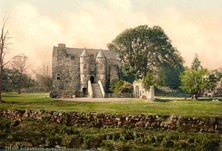 The year was 1828 and in the United States, it was an election year. Following Andrew Jackson’s loss to John Quincy Adams in 1824, the presidential campaign for 1828 began as soon as Adams took office in 1825 and lasted the entire length of his presidency. In 1824, neither candidate won a majority of electoral votes, so the election was decided in the House of Representatives. With support of House Speaker Henry Clay, Adams won and promptly named Clay his Secretary of State. This raised a public outcry that a “corrupt bargain” had tainted the election and kicked off the 1828 election very early.Â
The year was 1828 and in the United States, it was an election year. Following Andrew Jackson’s loss to John Quincy Adams in 1824, the presidential campaign for 1828 began as soon as Adams took office in 1825 and lasted the entire length of his presidency. In 1824, neither candidate won a majority of electoral votes, so the election was decided in the House of Representatives. With support of House Speaker Henry Clay, Adams won and promptly named Clay his Secretary of State. This raised a public outcry that a “corrupt bargain” had tainted the election and kicked off the 1828 election very early.Â
The campaigning on both sides was vicious and filled with personal attacks. Improved communication with the public through newspapers and events aimed at getting out the vote captured the attention of the American public. In fact, the number of voters in 1828 tripled that of the election of 1824.
One of the major issues at stake in the election of 1828 was that of Indian removal. In 1828, the Cherokees were proving proficient at a more agrarian style of living, farming and raising cattle. Schools were set up and Sequoyah invented a written version of the Cherokee language called “Talking Leaves.” In February of 1828 the Cherokee Phoenix became the first Native American newspaper to be published. But there was a demand for their land and the election of Andrew Jackson spelled disaster for the Cherokees and their Native American counterparts.
In the still young and fast-growing country, there was also the need for improved means of transportation, and on the Fourth of July ceremonies were held to break ground for the Baltimore & Ohio Railroad. When the railroad first took passengers, it was powered by horses. It wasn’t until August of 1830, that the line would begin its conversion to steam.
On that same day in Little Falls, Maryland, outgoing President John Quincy Adams broke ground on the Chesapeake & Ohio Canal. Construction on this route wouldn’t be completed until 1850 when it reached Cumberland, Maryland.
The Delaware & Hudson Canal opened for business in 1828 and provided a route for coal to be delivered from Pennsylvania coal fields to the port of New York via the Hudson River. The canal extended 108 miles from Honesdale, Pennsylvania to Kingston, New York.
Smallpox was reported in the city of Pittsburgh, Pennsylvania. On 12 November 1828, The Adams Centinel (Gettysburg, Pa.) reported that “at least four human beings [had] fallen victim to this scourge of our race, and from 20 to 30 others are infected with the disease.” The article goes on to encourage vaccinations, particularly to those exposed to the disease, and it appears that quite a few people heeded this advice. In the 3 December issue of that same newspaper, it was reported that “no less than 3,000 persons have been vaccinated within the past three weeks” and that “the Small Pox has been checked.”
Â
Across the ocean in London, the London Zoological Society opened the doors to its new zoo. The zoo wasn’t intended as a way to display animals to the public but to learn ways of domesticating foreign animals. In fact, the zoo wasn’t open to the public for the first three years; visitors were invited by society members. Nonetheless, 112,226 visitors managed to get in to get a peek at the exotic animals during that first year.
Click here for a printer friendly version of this article.






